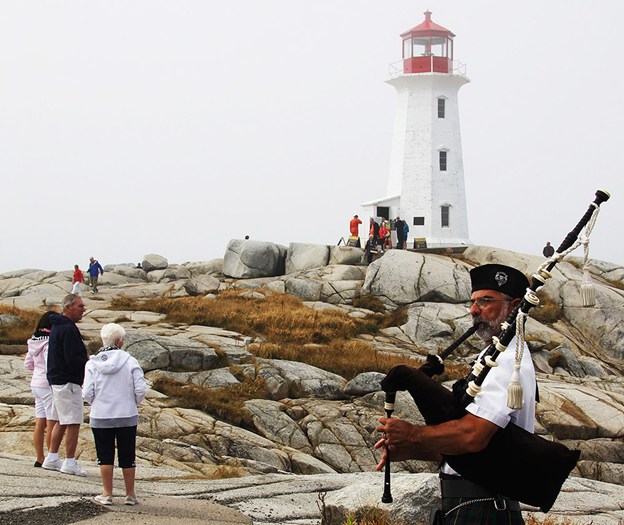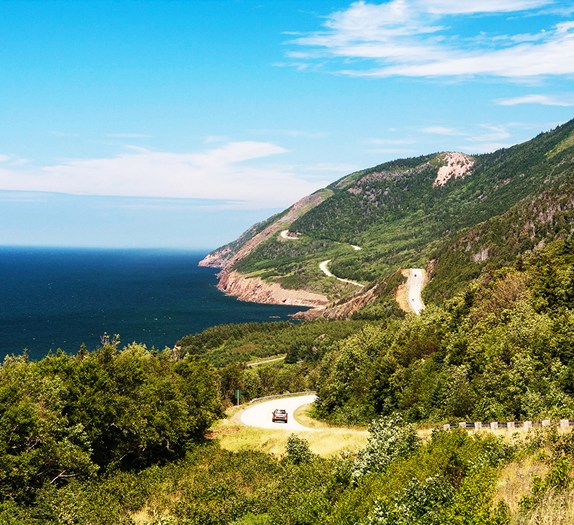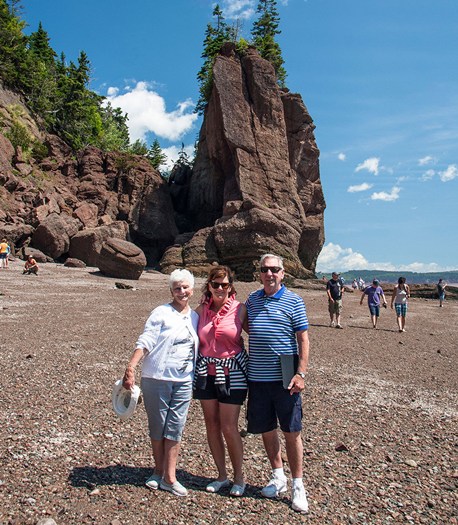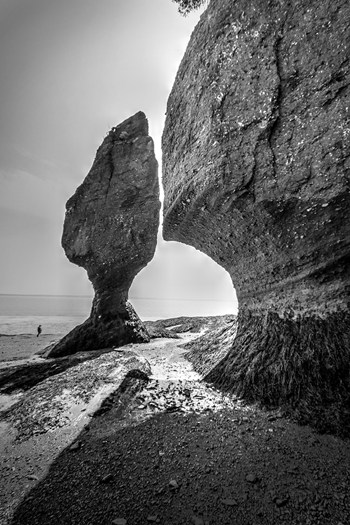HALIFAX - Here we were, at 12,000 metres, looking out over the royal blue skies and the fluffy cloud carpet below. Across the aisle, excited and distinctly Scottish accents engaged in rapid conversation made us both smile. My wife, Lorraine, had long wanted to take her Glaswegian parents on a road trip through New Scotland to see its beauty and to experience its culture. None of us were getting younger — her parents in their late 70s — so for Christmas we gave them this trip.
Planning of a trip like this is not easy at the best of times. Over 10 days, how many places can you see without rushing? What’s the travel distance between two points? How long do you stay at one location?
When planning a road trip with older people, you also have to take into account their stamina, their eating habits, their preferences and comfort level for accommodation. Consider that they may not be able to drive for too long without breaks for the bathroom or to stretch – stiff knees anyone?
So we planned accordingly and hoped for the best. For those of you interested in doing something similar, here’s how the vacation played out:
Day I and II – Halifax & Peggy’s Cove
Landing late in the afternoon, we started our journey leisurely by checking into our downtown Halifax hotel and going for a light walk to explore the wharf and have a spontaneous and impromptu seafood dinner at Murphy’s on the Cable Wharf. Nothing like starting a trip to the Atlantic coast with a fresh local lobster dinner.

Above: At Peggys Cove, a piper makes our Scottish friends fell right at home.
Off to the races, we were, first thing next morning. But beware — the weather can change very quickly here, and from location to location. What started as a beautiful sunny day in Halifax turned into London fog 45 minutes later when we neared Peggy’s Cove.
The quaint fishing village is everything you’d expect it to be; charming, rustic, just slightly touristy – but true to its roots – fishing boats come and go on their own relaxed schedule. The iconic lighthouse is postcard perfect, even shrouded in fog, but the quickly changing weather lifted the fog prior to our departure. While it was busy, it never seemed overcrowded.
Day III – Halifax
The next day we explored Halifax on foot and by car. My father-in-law Maurice is a history buff and as such was thrilled to tour the HMCS Sackville — a WWII Corvette convoy escort ship that’s been an official Naval Memorial since 1985 — and we were all delighted to tour the Halifax Citadel and witness the cannon going off at noon. Scottish kilts and tartans were abundant and the sweet mournful sound of bagpipes called to us from time to time, making the day entirely for my in-laws.
Day’s IV & V – Brier’s Island
This was the longest day of the trip, five hours to Brier’s Island – a remote speck off the northwest coast of Nova Scotia guarding the entrance to the Bay of Fundy. Admittedly a bit of a trek for Lorraine’s parents (and initially a concern for us), they soldiered through with nary a complaint (a few strategically placed bio-breaks helped to ease the drive and stretch the knees). After two ferries to get to the island, we checked in at the Brier’s Island Lodge.
The next day we checked off one bucket-list goal: We spent the morning on the ocean where we were awestruck to see two magnificent humpbacks both doing the familiar tail-up dive and swimming close alongside our boat, blowing their misty streams in the air. Outstanding!
Day VI – Pictou
En route to Cape Breton Island we stopped in beautiful quaint Pictou and stayed at a lovely B&B. Famous primarily because the first 200 highland Scots landed here in 1773, with waves of Scots following suit. Along the waterfront, on Water Street, one can see the many coats of arms and the tartans belonging to various clans alighting each signpost along the way.
Day VII – Glenora
None of us are Scotch drinkers. Nan has the odd white wine, and Maurice non-alcoholic beer. Why is this relevant? Because the next stop was at the Glenora Distillery and Inn, famous as the only Scotch whisky distillery outside of Scotland. Ranked in the top 50 spirits in the world by Wine Enthusiast magazine a few years ago, this is quality stuff. Did we try the Scotch? Yes indeed. After touring the facility and seeing firsthand the inner workings of the distillery itself, we were given a taste of a few of their better spirits. While I can’t say that any of us really appreciated the silky elixir, we did all try something we never had previously — another first on this trip.
Days VIII & IX – Spectacular Cabot Trail & Baddeck
With smiles on our faces, we headed onto the pride of Cape Breton Island, the spectacular Cabot Trail, via Highway 19. We did this in two days, but one could easily spend three to four days on this amazing route, stopping at the many small villages, visiting the craft and specialty shops and drinking in the natural splendour that is this great place.

Above: A drive along the Cabot Trail brings back memories of the Scottish coast.
Buy a real lobster trap, have high tea in the afternoon, or hike the famous Skyline Trail. Picture postcard beauty abounds everywhere here, and is why it is considered one of the world’s most scenic destinations. As a matter of fact, Cape Breton Island was rated the No. 1 Island to visit in continental North America by Travel & Leisure magazine.
All along the way, signs in both Gaelic and English dot the landscape to announce the coming towns and villages. We ended our most amazing visual day of the vacation so far at the town of Baddeck, home of Alexander Graham Bell and sporting a museum in his name. After visiting here you’ll be astounded at his many inventions beyond the telephone.
Day X – Alma and Hopewell Rocks
Nan was looking forward to our last stop the whole trip, what she called the Red Rocks. Hopewell Rocks is famous for having the highest tide differential in the world – 16 metres between high and low tide.
Visitors from all over the world come here to walk on the ocean floor at low tide. And so did we. Arriving just before noon (check the tide tables online before you go (thehopewellrocks.ca/learning-centre/tide-tables) we made it down the 99 steps to the dry seabed. It’s amazing how the idea of being in a place such as this can drive people to walk or climb more than they normally would just to be able to participate in this once-in-a-lifetime treat.


Left: Nan, Lorraine and Maurice stand on the Ocean floor at low tide at Hopewell Rocks. Right: The sculpted flowerpot formations at Hopewell Rocks were all memorable parts of the journey to Nova Scotia.
Neither Nan nor Maurice disappointed us, and in fact rejoiced at being able to walk on the bone-dry sea floor amongst the giant flowerpot rocks and seaweed.
Awesome!
Another item checked off the bucket list.
I wrote in the picture book we gave them to commemorate this trip: “This week, we laughed a lot, and were constantly amazed by the beauty of this area of the world. Wonderful food was had, we all tried Scotch (even though none of us liked it) and we had a great time all in all. We are so happy we had the chance to do this with you.”
As the MasterCard ads say: Priceless!
About the Author

From tracking and naming a female Humpback Whale in Moorea, near Tahiti; in a hot air balloon adventure over the Napa wine valley, to visiting a native community two hours by canoe into the depths of the Ecuadorian Amazon, Mark has brought many adventure travel stories and images to readers across the country. A freelance contributor to TraveLife magazine, Mark also is a regular contributor of travel features to ExtraOrdinary Health Canada Magazine; and has been published in the Toronto Star, the National Post, and Air Canada’s EnRoute magazine, and in Photographer’s Forum: Best of Photography. Mark studied photography at Toronto’s Ryerson University. Mark’s been fortunate enough to travel to places many people dream of in addition to those mentioned previously; The Galapagos islands, Bora Bora, Taha’a, Raiatea, Costa Rica, extensively through the Caribbean, Puerto Rico, Mexico, Florida, California, Alberta, B.C., England and Scotland. Favorite spot? That’s a hard one – there have been so many but at the end of the day it’s no contest: Bucket list Bora Bora.